RESCUE
Rescue is a small hamlet on the Chicago, Burlington and Quincy Railroad, 8½ miles North and 12½ miles West of Wahoo.
One of the best machine shops in this section of Nebraska has been located in Rescue. It is owned and operated by Anton Wirka, son of Anton and Anna Snows Wirka. Anton's wife was the former Gladys M. Satorie.
An early settler was Frank Wirka. He was born near Rescue on January 7, 1872.
The post office was established here on June 23, 1874. Milton M. Runyan was Postmaster. It was discontinued July 1, 1900, then reestablished March 11, 1903, with Mary Palensky as Postmistress, then discontinued October 31, 1933.
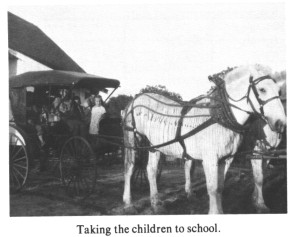 |
| Taking the children to school. |
HISTORY OF PRAGUE
1887-1983
The First Settlers of Czech origin to settle in this area came in 1867. Peter Kastl was the 1st to homestead about seven miles southwest of Prague. Anton Hajek was the next, coming in 1868. They were followed by the following, many of them still common names in the community: Jos Simanek, Thomas Simanek, John Vanous, Joseph Kaspar, John Kubalek, Vac Kaspar, Mathew Vavak, John Placek, Jos Pop, Michael Petrzelka, John Cizek, Vac Cizek, Jos Knajdl, Frank Ruzek, Vac Mikulas, Jos Bures, George Simanek, John Mach, John Kaspar, George Elbing and others.
In the spring of 1887, the Omaha and North Platte Railroad (not in existence anymore) began the construction of a branch line from Ashland to Schuyler. Prague was selected as a site for one of their stations. The land where Prague now stands, comprised of 160 acres, was owned by Joseph Kaspar. The Lincoln Land Co., buyers of the land, divided it into lots and proceeded with the sale of them, thus the Village of Prague was started.
The first building of the town was a saloon built by Frank Pop and commenced business on Sept. 15, 1887. About the same time Frank Kubik and W. C. Kirchman built a general store, Joseph Sedlacek, a saloon and Secor and Kaspar a hardware store. At this time, the railroad has been built as far as Prague and the first train arrived October 1887.
In October 6, 1888, with a population of 200, the village was incorporated. The first grain elevator, harness shop and blacksmith shop were built. Later other businesses were started, such as: a flour mill, a cigar factory, wagon shop, 1st Prague Hotel in 1888, furniture store in 1892.
During this time, a firm that was probably identified more with the early History of Prague than any other was that of Henry Fisher of Wahoo and Thomas Simanek of Prague. They formed a partnership and established a lumber yard.
In the earlier years, many hardships were experienced by the settlers, the plague of grasshoppers in 1874, crop failure due to hot, dry weather, the blizzard of 1888 and the hailstorm in 1895.
Two churches were established in this oommunity, the Bohemian Presbyterian church in 1879, the St. John Catholic church in 1901, which no longer stands and is being replaced by a new church.
The first water works and light plant were erected in 1906. Another great improvement was made in 1931, when 16 blocks of pavement were laid. In 1970, the rest of the streets in the village were paved. A sewer system was constructed in 1960.
The first school was located a half mile from the edge of town which was built in 1878 and was named Dist. 104. However, due to the large enrollment, another school was built in 1889 in the village of Prague. In 1921, the school house burned down and a new building was erected (which still stands). A new gym was built in 1975. A parish school was started in 1921. This building housed the Prague Hospital, built by Dr. Jos F. Kaspar in 1913. At present the building stands but is not occupied.
The Prague Volunteer Fire Dept. was organized after the fire of 1898. In 1929, a new fire truck was purchased, later replaced in 1933. Over the period of years, the department has purchased First aid Unit in 1962. A new fire house was built in 1981. In 1970, the village lost three businesses due to a fire: Gates Hardware Store, Prague Cafe and Bar and Sedlacek Service.
The present businesses located in the village of Prague are: Home Lumber Co. which is managed by Clarence Egr. The First Lumber Co. was built by Thomas Simanek and Henry Fisher in 1887. Over the period of years it was managed by Ignac Simanek, Adolph Simanek, Joe Pabian and Henry Vlcan.
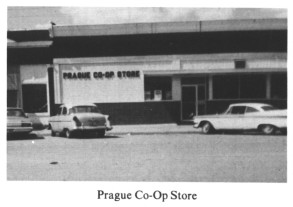 |
| Prague Co-Op Store |
The Prague Co-op Store is managed by Bob Humlicek. Originally, this store was established as a general merchandise store in 1899 by the Safranek Bros. In 1909, Kliment Mercantile Co. was organized with J.A. Kliment manager, later it became the Farmer's Union Exchange.
Shimerka Implement Co. was organized in 1936 by V.R. Shimerka. He became a John Deere Plow Co. dealer. The business was first housed in Belik Produce. In 1938, the business was relocated to the present location. Richard Shimerka is the present owner and manager.
Eddie's Bar is owned by Eddie and Lucille Prochaska. This building was built in 1916 by the Fremont Brewery. In 1980, the building was remodeled and a restaurant was added.
Mobil Oil and Service Co. is operated by Kenneth Kuncl. Originally this new building was built by Sid Sedlacek.
Kucera Funeral Home was organized in 1951 with Gordon Kucera as present funeral director.
The Belik Produce was established in 1945 by Ernest Belik. After he passed away, his wife, Rose, continued in the business.
Gates Hardware was purchased in 1953 from O.C. Matous. In 1970 this building was destroyed by fire. Since then, he has been doing business out of his home.
The Prague Bar has had many previous owners. It started as a bar in 1933 by Mike Havel. The present owners are Jackie and Ralph Kunc.
The town boasts three beauty shops. The Corner Shop by Cynthia Karstens, Linda's Beauty Shop by Linda Belik, and Pearl's Shop by Pearl Fendrich.
Belik's Auto Repair; this business was opened in 1971 by Marvin Belik.
The Bank of Prague was organized in 1906. In 1975, a new building was built. The present officers are: Ed Carlson, chairman; Gene Karstens, cashier; Mrs. George Egr and Mrs. Duane Urban, Assistant cashiers.
The Telephone exchange was originally built near the turn of the century and operated by various firms over a period of sixty years. In 1959, the Northeast Nebraska Telephone Co. acquired this system. The entire system was rebuilt for modern dial services.
A new post office was built in 1959. The present post mistress is Dorothy Vavak.
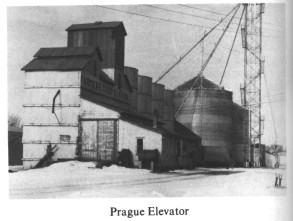 |
| Prague Elevator |
The Farmers Co-op Elevator Co. was incorporated in 1918 before that it was the Farmers Grain Co. Myron Coufal has been manager for the past eleven years.
In 1987, the village of Prague is planning to celebrate its Centennial years.
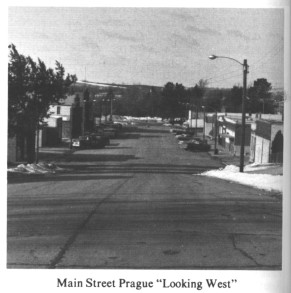 |
| Main Street Prague "Looking West" |
"PROMINENT MEN IN PRAGUE
OVER THE YEARS"
Dr. Reynold E. Vlasak -- son of John J. and Anna (Wirka) Vlasak was born in Prague, Nebr., February 1, 1902 and passed away at the Saunders County Hospital April 23, 1958.
He had practiced dentistry in Prague since 1931 with the exception of a year and a half when he was in the U.S. Navy during World War II.
Dr. Joseph F. Kaspar, M.D. -- was born September 28, 1876 to Joseph F. and Mary (Ruzek Kaspar, one ofthe founders ofthe Village ofPrague. He interned at Bellevue Hospital in New York City and stayed to practice medicine there for two years. He then returned to Prague where he spent his life taking care of his community, with the exception of one year post graduate at the University of Prague, Czechoslovakia in 1912. In his entirety he practice continuously some fifty-five years and passed away March 28, 1955.
Frank J. Kolbaba -- studied violin, cello, viola and double bass at the Prague Conservatory of Music. He was a professor of music at Luther College and Prague High School 1939-1954.
Dr. A. W Bohaboy, D.M.V. -- born Oct. 7, 1889, son of Frank and Anna Bohaboy. He established a veterinarian practice in Prague in 1912.
page 64
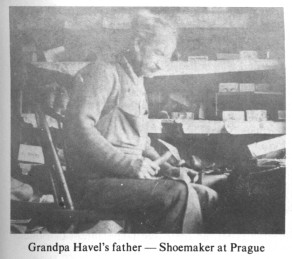 |
| Grandpa Havel's father -- Shoemaker at Prague |
Louis J. TePoel -- a prominent attorney who was born northeast of Prague. He was Dean of the Creighton University Law School at Omaha, Nebr. for 25 years.
Dr. George F. Simanek -- born south of Prague and was a head surgeon of St. Joseph's Hospital, Omaha, Nebr. for 25 years. In 1962 he celebrated 50 years in the medical field.
John Pabian, Sr. -- About 1893 he moved to Prague from Omaha and built a blacksmith shop. Three of his sons followed him in the business.
Joseph F. Kucera -- grew up in Prague and helped the community grow with his profession as carpenter. He started in 1904 and for the following 56 years followed this trade.
James Kucera -- a brother to Joseph, spent the greater part of his working years as a carpenter. In 1913 he entered carpentry and retired in 1947.
Joseph J. Urban -- resided in Prague and his trade of carpentry helped build the Public School, Shimerka Implement building, and several homes in Prague. Started in 1925 and worked until his retirement in 1958.
James Petrzelka, Sr. -- came to Prague in 1887 and was a painter, carpenter, and paper hanger. He helped to build the National Hall. Prague Public School, and the Catholic Church.
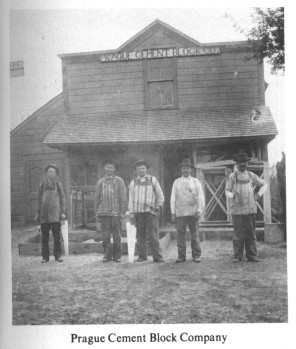 |
| Prague Cement Block Company |
ST. JOHN THE BAPTIST
CATHOLIC CHURCH: PRAGUE
St. John's Church, a 36 by 90 ft. white frame building, was built in 1901. The bells in its lovely cross-topped belfry rang out both time and devotion. The original wallpaper and wainscott interior was completely updated with pastel NU-WOOD blocks, lovely new stations of the cross and new light lixtures in the 1940's.
In 1905 a parish house was acquired and in 1917 demolished and replaced by a then fashionable big square house. It was renovated and still in use today.
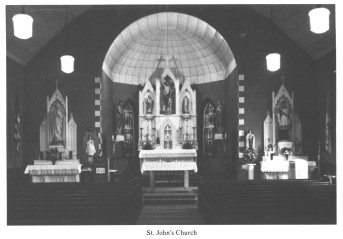 |
| St. John's Church |
The wooden Opera house downtown was purchased for a recreation hall in 1928 and replaced by the red brick garage building in the 1950's. Both halls have served well for numerous meetings, receptions, bazaars, classes and the like.
In 1921 a stately gray brick hospital building was bought and remodeled for a parochial school. From the beginning till its closing in 1973 it was staffed by the Notre Dame Sisters of Omaha. The fourth "R" in the classroom endued the love of the faith in elementary school children.
In 1964, St. John became one of the ten parishes involved in the building and yearly support of Neumann High School, Wahoo. This enables secondary school children to continue their Catholic education.
Five young women from the parish became N.D. nuns namely: Sisters Barnadine, Pauline and Leona of the Ludvik Mazanec family and Sisters Agnes and Mildred of the Frank Ostry family. On June 4, 1953 a young man, Rev. Ernest Sloup, was ordained to the priesthood at St. John's.
The priests who served the parish for two years or more were: Fathers John Vlcek 1904-1908; Vaclav Pokorny 1908-1920; Martin Bogar 1920-1924; Horacek 1927-1930; Alfonse Biskup 1930-1934; Bede Cernik O.S.B. 1934-1938; Joseph A. Tupy 1938-1950; Wm. Rezabek 1950-1968; George Stoeckinger 1968-1970; Donald Imming 1970-1972; Ray Roh 1972-1976; John J. I;lcCabe 1976-1981 and the present pastor Fr. John G1aves.
Laypeople are the important living stones of a parish and organizations show them how to give of themselves better. These are functioning for us today.
1) Catholic Workman Lodge -- life insurance and helps in spiritual life.
2) Rosary Altar Society -- devotion and buying supplies for the Altar and sanctuary
3) PCCW organizes work groups, has money-making projects.
4) Volunteers teach catechism to the children.
5) Lectors, acolytes, altar boys, organists and a choir assist the priest at Masses.
This year, 1982, ten men on the Building Committee were especially important. They, along with Father Glaves, shouldered much of the decision making about the building of a new brick church, the excavation already having been started. This structure, priced at $350,000 has the backing of 125 parishioners who pledged $250,000 for the next three years. With the new architecture and the fact that the church, day chapel, hall and classroom will be altogether on the 81,000 sq. ft floor will save on heating bills so important nowadays. Submitted by Clara Virka
PRAGUE UNITED
PRESBYTERIAN CHURCH
In 1867 several protestant families came from Czechoslovakia, settled in the northwestern part of Saunders County in area west of what is now the town of Prague. They met in their homes to fulfill their need to worship God and have spiritual fellowship. At that time there wasn't a Czech speaking minister in the area. But traveling Baptist and Methodist ministers often came and preached to them in the English language which was translated to the Czech language by Jan Chleboun, a member.
In 1877, they were encouraged by Rev. Kun, of Iowa, who visited them once a year, to baptize babies and perform marriage ceremonies, to organize their own congregation. Jan Chleboun was chairman, elders were Jan Kubalek, Joseph Vrana, John Placek and James Novak. They called themselves the "Cesky Bratersky Evangelicky" congregation.
They purchased a 40 acre tract of land west of Prague, SW¼ of SW¼, section 3 township 15, range 5. John Placek purchased a school building which was moved onto the land, later, it was remodeled for worship services. A portion of the land was set aside for a burial ground and is located in original spot.
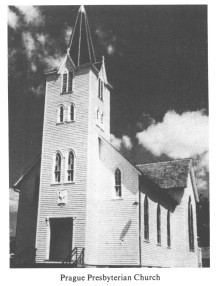 |
| Prague Presbyterian Church |
page 65
| 
